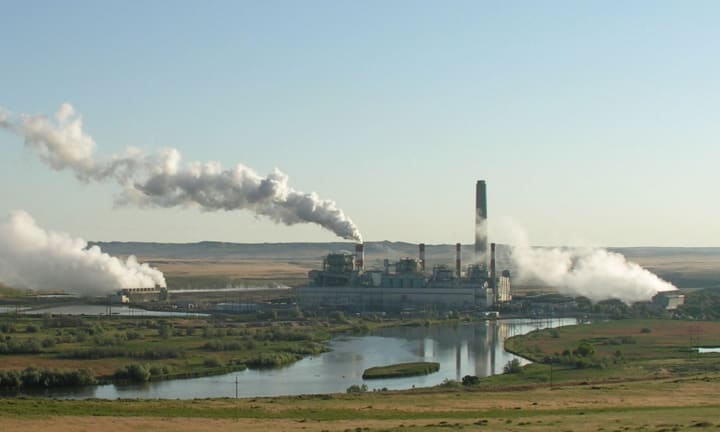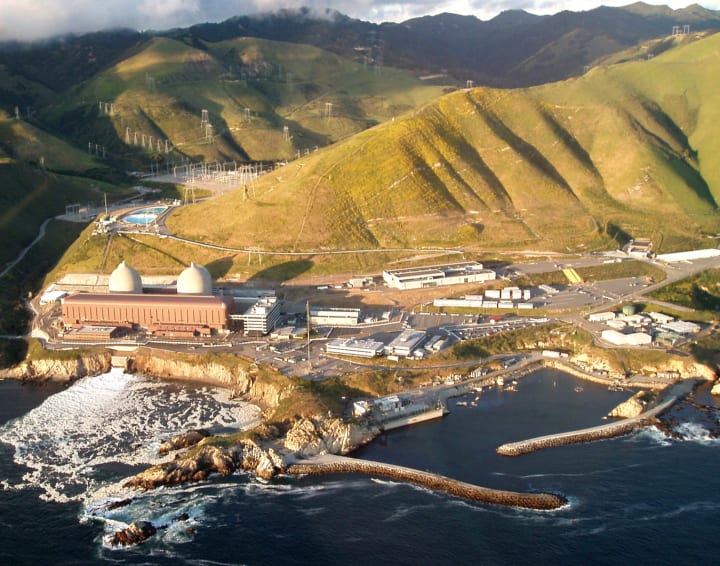Cost Effective or Carbon Free?
Clean power comes with a cost.

Our way of life has consequences we choose to ignore. We enjoy driving our car down the highway. We expect electricity in our homes to power the things we feel we need. What people do not appreciate is seeing the effects of pollution that comes from the production of items that make our way of life sustainable. One of the most significant contributors to climate change comes from utilizing coal to generate electricity and, as a result, some people argue for the immediate shutdown of coal-power facilities to reduce that pollution in our environment. While quick closures of all coal-power plants will quickly, and significantly, minimize air pollution, instead, it is much more important to utilize technology to refit such facilities to reduce pollution at a pace that will not devastate the economy.
Dave Johnson Coal-Fired Power Plant, Wyoming

Wikimedia Commons Image
People must understand that, when speaking of coal-power, there are three main issues, namely: coal’s contribution to pollution, its abundance, and cost. Coal power plants release millions of tons of pollutants that contribute to global warming, for instance: sulfur, carbon, and nitrogen compounds (Union of Concerned Scientists, 2017). These airborne pollutants also contribute to acid rain and smog (ibid). Particulate matter and ash released from smokestacks and cooling towers add to lung damage and toxic metal contamination. The pollution released by coal power generation is vast. Secondary processes from these plants also add pollution.
Large bodies of water, such as rivers or lakes, serve as the primary water source used to cool the boiling processes at these facilities (EPA, 2007). This secondary process removes water and, after use, redistributes it back into the water source thus raising its natural temperatures (ibid). Plants with built-up wastewater ultimately discharge it back into the water source. Finally, run-off water, because of raining, can run out to the surrounding environment further spreading that facility’s pollution (ibid). These are but a small list of ways coal-generated power spreads pollution throughout the environment. These facilities exist because of coal’s cheap cost and abundance.
Coal is a vast source of fuel for the generation of electricity in this country. Between 1990 and 1999, the use of coal was responsible for over 50 percent of this nation’s energy consumption (EIA, 2003). In 2009, coal was still responsible for almost 50 percent of this nation’s energy use (CBSNews, 2009, p. 1). Our significant use of this energy source leads us to realize a dilemma: If we turned off all our coal-power plants tomorrow, the nation would then not be able to power its way of life. We would cripple our economy despite the benefits of not having carbon-related pollution in the environment. Also, because it is a cheap fuel, the cost for such energy production is low. People want their basic needs fulfilled while having enough of their earnings left over to have a life. It makes sense, although unfair to the environment since the energy users are the ones who have to pay for the electricity. The use of coal fulfills those basic needs.
Earth in a Green House Gas Stove

Wikimedia Commons Image
Coal-generated electricity is the single most significant contributor to greenhouse gases (CBSNews, 2009, p. 1). Coal power processes release a substantial amount of carbon into the atmosphere. Carbon is the major contributor to greenhouse gases and climate change (WNO, 2017). A solution to a problem of carbon emissions involves the use of clean-coal technologies (Union of Concerned Scientists, 2017). The coal-power industry designed clean-coal technologies to reduce harmful industrial pollutants released into the environment by diverting and filtering emissions before release into the atmosphere (ibid).
Clean Energy Expansion

Wikimedia Commons Image
While the use of clean-coal generation facilities, to include carbon sequestration, are a viable solution towards reducing greenhouse gases, the cost to build such facilities significantly delays their manufacture within this country (CBSNews, 2009, p. 2). Only two coal power facilities in the United States utilize a full-scale capture and sequestration technology that has carbon emissions redirected to the ground (ibid). Similar and more advanced techniques, such as those from the Texas Clean Energy Project, project a carbon and other greenhouse gas emissions reductions by 90 percent or greater once it is fully operational (Office of Fossil Energy, n.d.). Technology develops many ways for society to reduce pollution from coal plants. Unfortunately, there is not enough support to push these technologies into much broader use and at a faster pace.
Scientists and organizations disagree about the need to refit or shut down coal facilities or when they can make these changes (CBSNews, 2009, p. 2-4). Global warming proponents state that changes need to occur immediately (i.e., refit or shutdown). One energy provider says it can happen over several decades (ibid). Response to such change over several decades is harsh with claims that the environment won’t survive such delays. Additionally, there is an enormous cost (billions for facilities – trillions for infrastructure) for facilities with carbon sequestration and other clean-coal technologies (ibid). Implementing these changes immediately, throughout the more than 100 active coal power plants in this country is not possible in the period needed by the scientific community without severely hampering the economy. Alternatives to this solution lie in renewable energy technologies that are not yet ready for widescale use throughout this country.
Pollution over East China

Wikimedia Commons Image
Scientists do not base their argument solely on mathematical models of prediction. They are not just stating, “Something will happen.” Instead, adverse effects are already evident as a result of poor pollution controls. The effects of carbon as well as other forms of pollution by industrial societies are apparent in China (Kahn, 2007). If any of us wish to see what unchecked industrial growth does to the environment and its inhabitants, we need only look towards that country. Scientists are correct in that change needs to occur immediately. Energy providers are right that immediately shutting down or refit of power facilities will devastate the economy. Society needs to make these groups find a middle ground before our environment forces that change for us.
The best immediate alternative to coal as a fuel is to utilize renewable energy sources such as wind, water, or solar power (EIA, 2011). Hydroelectric power, such as that generated at Niagara Falls or Hoover Dam, is virtually pollution free. Unfortunately, such sources of water do not exist everywhere. Wind and solar energy are useful sources of power but are nowhere near a level that produces the same amount of cheap power that coal provides (WNO, 2017). In fact, the use of renewable energy within this company pales in comparison to that generated by coal (EIA, 2003).
Diablo Canyon Nuclear Power Plant

Wikimedia Commons Image
Another option is to utilize nuclear power to replace that power already generated by coal (EIA, 2011). Nuclear power is a reliable alternative to coal power that currently supplies up to 20 percent of this nation’s energy consumption. However, with nuclear accidents such as Chernobyl, Three-Mile Island, and Fukushima Daichi, it is unlikely society will allow the construction of enough nuclear power plants to replace that power provided by coal (Wikipedia, 2018). For instance, due to the events of Three Mile Island, society did not allow new plant construction for at least 30 years (ibid). Finally, nuclear power, although carbon free, is not necessarily pollution free. For example, waste generated by nuclear plants in this country must be stored indefinitely (i.e., for thousands of years). Additionally, the laws in place prohibit reprocessing used nuclear fuel.
Endless Stagnation and Bureaucracy

Wikimedia Commons Image
Catastrophe seems to be a driving force for progress in our society. We’ve all experienced some turmoil in our lives that have caused a change in something inside of us. Some smoker’s, for instance, stop smoking if their habit caused them to develop cancer. Before cancer occurred, they chose to continue their smoking unabated. Once the disease threatens their life, the need for change is apparent. Similarly, our demand for energy causes us to ignore the “cancer” enveloping the environment. Some of us in society make an effort to offset the effects of pollution. Unfortunately, it is not enough.
Our environment will continue to deteriorate if we do not enact short-term solutions to the carbon emissions released from coal power. Conversely, creating change at too fast a pace will lead to hardships on the economy that society will not tolerate. Change is expensive and will take some time to implement. If people see corporations, government, and scientists working together to make these changes occur in the immediate future, they will support these changes despite some hardships as a result of them.
We must push our leaders to continue pressing our industry to produce power that is pollution free. We must also urge our leaders to mandate that the power industry utilizes carbon sequestration within a short span of time (i.e., ten years), versus allowing them to operate virtually unchecked for decades. Our best option, at this time, is to change the way coal is utilized for power production while we wait for coal alternatives to further develop at a much faster pace than what is proposed by industry (i.e., renewables). The research is available for carbon sequestration. The technology is in use (CBS, 2009, p. 3). Cost is not a sufficient reason to prevent implementation. Unless our society stands together and demands the application of such clean coal technologies, within a reasonable period (i.e., years versus decades), we will have no choice but to sit while we pollute our environment to fulfill our energy needs.
References:
a. CBSNews (April 27, 2009). “The Dilemma Over Coal Generated Power” (p. 1-4). Retrieved from: http://www.cbsnews.com/2100-18560_162-4964301.html.
b. Energy Information Administration (EIA) (2003). “Electricity Net Generation by Fuel:1990, 1995-1999 U.S. Total”. Retrieved from: http://www.eia.gov/cneaf/coal/statepro/imagemap/us2p1.html
c. Energy Information Administration (July 21, 2011). “Electricity in the United States –Energy Explained, Your Guide to Understanding Energy.” Retrieved from http://www.eia.gov/energyexplained/index.cfm?page=electricity_in_the_united_states
d. Environmental Protection Agency (December 28, 2007). “Clean Energy: Coal.” Retrieved from: http://www.epa.gov/cleanenergy/energy-and-you/affect/coal.html
e. Kahn, J., and Yardley, J (August 26, 2007). “As China Roars, Pollution Reaches Deadly Extremes.” New York Times. Retrieved from: http://www.nytimes.com/2007/08/26/world/asia/26china.html
f. Office of Fossil Energy. Texas Clean Energy Project. Retrieved from: https://www.energy.gov/fe/texas-clean-energy-project
g. Union of Concerned Scientists (UOCS, 2017). “How Coal Works.” Retrieved from: https://www.ucsusa.org/clean-energy/all-about-coal/how-coal-works#.W1BvEi3MzUI
h. Wikipedia (July 7, 2018). "Nuclear and radiation accidents and incidents" Retrieved from https://en.wikipedia.org/wiki/Nuclear_and_radiation_accidents_and_incidents
i. World Nuclear Organization (September 2017). Managing Wastes from Coal. “Clean Coal Technologies, Carbon Capture, and Sequestration.” Retrieved from: http://www.world-nuclear.org/information-library/energy-and-the-environment/clean-coal-technologies.aspx







Comments
There are no comments for this story
Be the first to respond and start the conversation.